Page 3759 of 4264
ON-VEHICLE SERVICE (AW30 –40LE) 7A3-3
Location of Clutch, Brake, One-Way Clutch and Solenoid
RUW37ALF000201
Legend
(8) One-way clutch (No.2) (F–2)
(1) Overdrive direct clutch (C–0) (9) Shift solenoid (S–1)
(2) Overdrive brake (B–0) (10) Shift solenoid (S–2)
(3) Direct clutch (C–2) (11) One-way clutch (No.1) (F–1)
(4) Second coast brake (B–1) (12) Pressure control solenoid (STH)
(5) Forward clutch (C–1) (13) Lock-up solenoid (SL)
(6) Second brake (B–2) (14) Overdrive one-way clutch (F–0)
Page 3760 of 4264
7A3-4 ON-VEHICLE SERVICE (AW30 –40LE)
Operation of Clutch, Brake and One-Way Clutch
Transmission Identification
RUW37ASH004301
Legend
(1)
Transmission Model Number
(2)
Production Serial Number
The identification plate is located on the right rear side
of the transmission.
Page 3761 of 4264
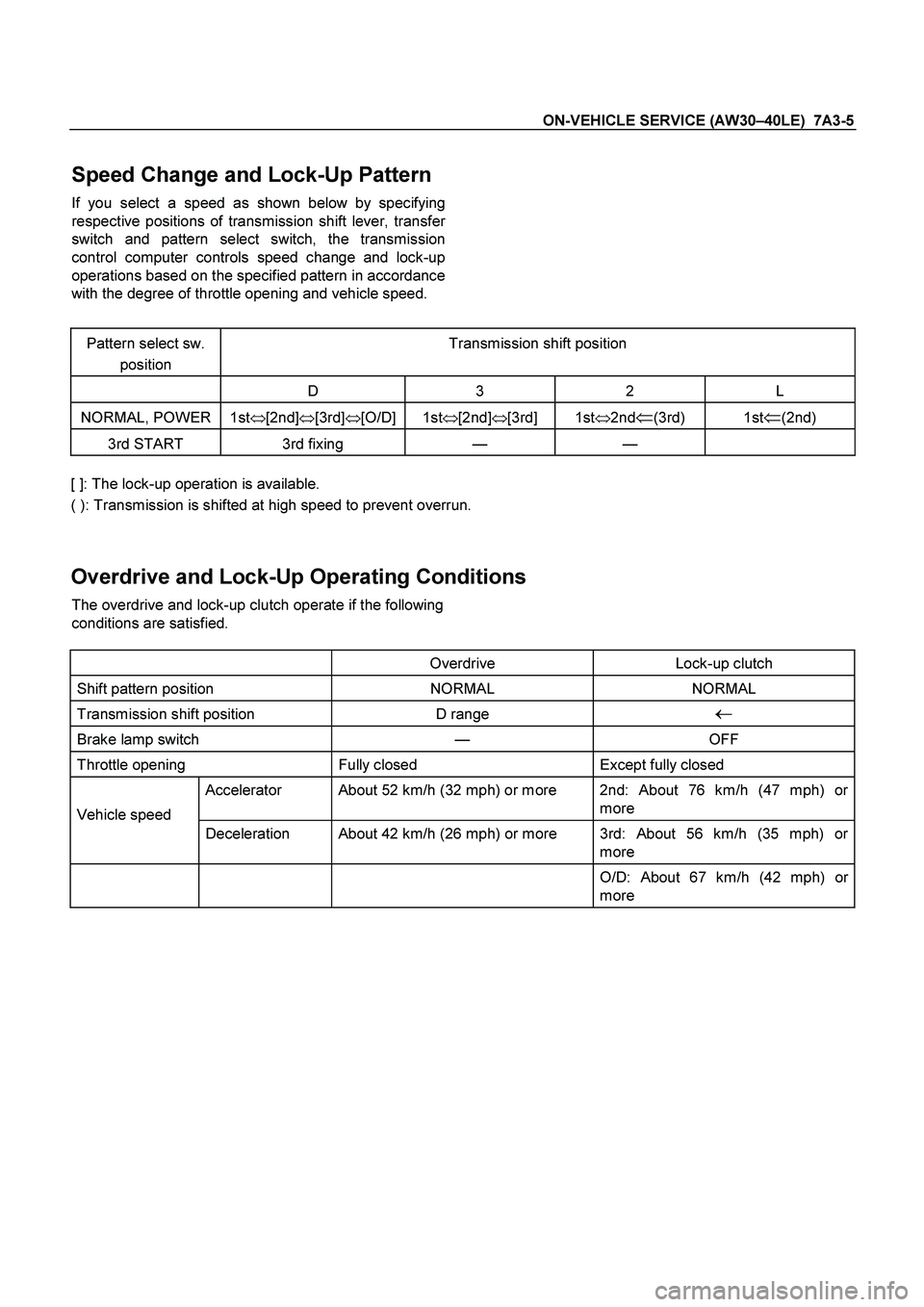
ON-VEHICLE SERVICE (AW30 –40LE) 7A3-5
Speed Change and Lock-Up Pattern
If you select a speed as shown below by specifying
respective positions of transmission shift lever, transfe
r
switch and pattern select switch, the transmission
control computer controls speed change and lock-up
operations based on the specified pattern in accordance
with the degree of throttle opening and vehicle speed.
Pattern select sw. position Transmission shift position
D 3 2 L
NORMAL, POWER 1st �
[2nd] �
[3rd] �
[O/D] 1st �
[2nd] �
[3rd] 1st �
2nd�(3rd) 1st�(2nd)
3rd START 3rd fixing — —
[ ]: The lock-up operation is available.
( ): Transmission is shifted at high speed to prevent overrun.
Overdrive and Lock-Up Operating Conditions
The overdrive and lock-up clutch operate if the following
conditions are satisfied.
Overdrive Lock-up clutch
Shift pattern position
NORMAL NORMAL
Transmission shift position
D range ��
Brake lamp switch
— OFF
Throttle opening
Fully closed Except fully closed
Accelerator About 52 km/h (32 mph) or more 2nd: About 76 km/h (47 mph) or
more
Vehicle speed Deceleration About 42 km/h (26 mph) or more 3rd: About 56 km/h (35 mph) or more
O/D: About 67 km/h (42 mph) or
more
Page 3769 of 4264
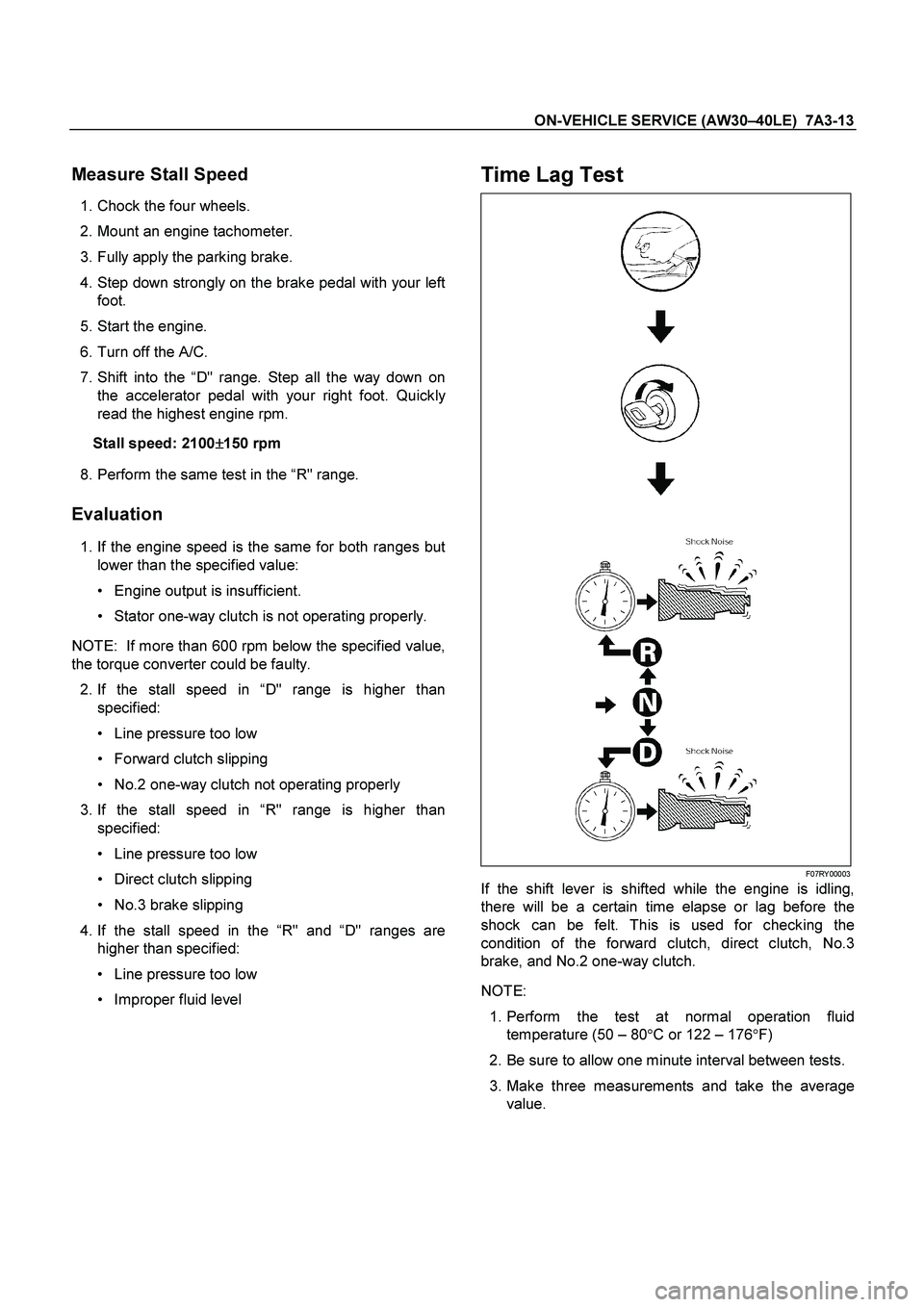
ON-VEHICLE SERVICE (AW30 –40LE) 7A3-13
Measure Stall Speed
1. Chock the four wheels.
2. Mount an engine tachometer.
3. Fully apply the parking brake.
4. Step down strongly on the brake pedal with your left foot.
5. Start the engine.
6. Turn off the A/C.
7. Shift into the “D" range. Step all the way down on
the accelerator pedal with your right foot. Quickl
y
read the highest engine rpm.
Stall speed: 2100 �
� �
�
150 rpm
8. Perform the same test in the “R" range.
Evaluation
1. If the engine speed is the same for both ranges but
lower than the specified value:
Engine output is insufficient.
Stator one-way clutch is not operating properly.
NOTE: If more than 600 rpm below the specified value,
the torque converter could be faulty.
2. If the stall speed in “D" range is higher than
specified:
Line pressure too low
Forward clutch slipping
No.2 one-way clutch not operating properly
3. If the stall speed in “R" range is higher than
specified:
Line pressure too low
Direct clutch slipping
No.3 brake slipping
4. If the stall speed in the “R" and “D" ranges are
higher than specified:
Line pressure too low
Improper fluid level
Time Lag Test
F07RY00003
If the shift lever is shifted while the engine is idling,
there will be a certain time elapse or lag before the
shock can be felt. This is used for checking the
condition of the forward clutch, direct clutch, No.3
brake, and No.2 one-way clutch.
NOTE:
1. Perform the test at normal operation fluid
temperature (50 – 80 �C or 122 – 176 �F)
2. Be sure to allow one minute interval between tests.
3. Make three measurements and take the average value.
Page 3770 of 4264
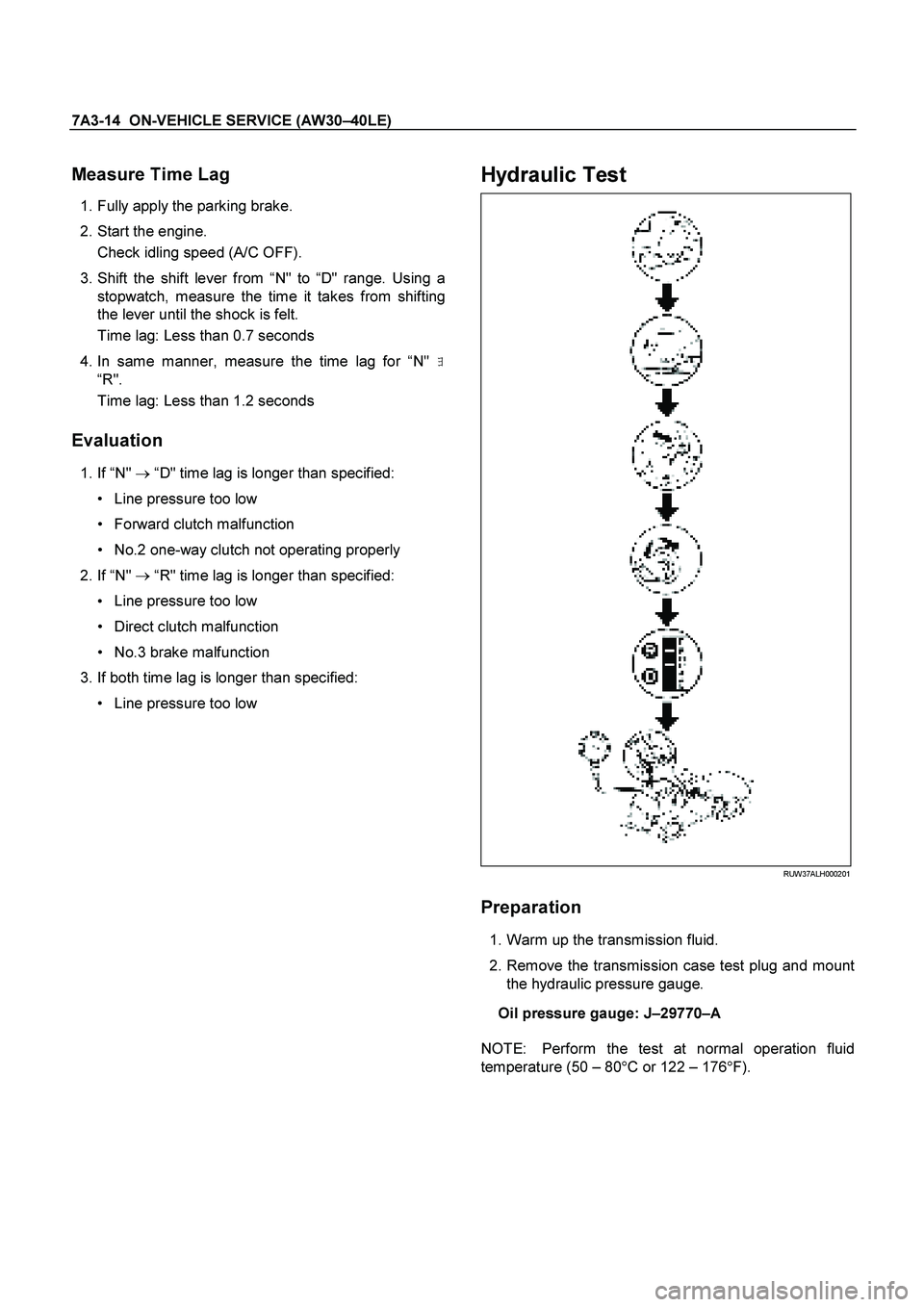
7A3-14 ON-VEHICLE SERVICE (AW30 –40LE)
Measure Time Lag
1. Fully apply the parking brake.
2. Start the engine. Check idling speed (A/C OFF).
3. Shift the shift lever from “N" to “D" range. Using a
stopwatch, measure the time it takes from shifting
the lever until the shock is felt.
Time lag: Less than 0.7 seconds
4. In same manner, measure the time lag for “N"
�
“R".
Time lag: Less than 1.2 seconds
Evaluation
1. If “N" �
“ D" time lag is longer than specified:
Line pressure too low
Forward clutch malfunction
No.2 one-way clutch not operating properly
2. If “N" �
“ R" time lag is longer than specified:
Line pressure too low
Direct clutch malfunction
No.3 brake malfunction
3. If both time lag is longer than specified:
Line pressure too low
Hydraulic Test
RUW37ALH000201
Preparation
1. Warm up the transmission fluid.
2. Remove the transmission case test plug and mount the hydraulic pressure gauge.
Oil pressure gauge: J –29770 –A
NOTE: Perform the test at normal operation fluid
temperature (50 – 80 �
C or 122 – 176 �
F).
Page 3771 of 4264
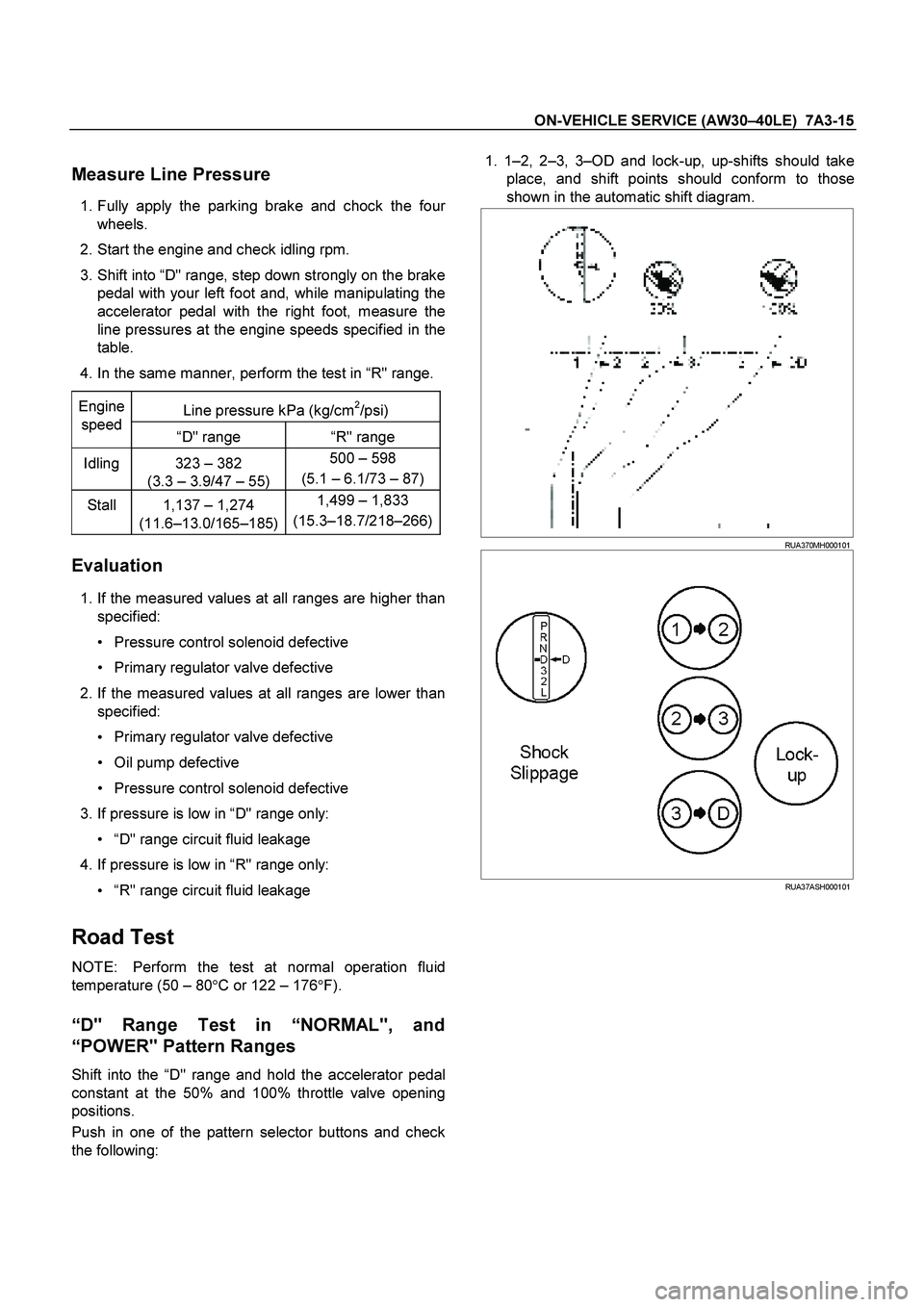
ON-VEHICLE SERVICE (AW30 –40LE) 7A3-15
Measure Line Pressure
1. Fully apply the parking brake and chock the four
wheels.
2. Start the engine and check idling rpm.
3. Shift into “D" range, step down strongly on the brake
pedal with your left foot and, while manipulating the
accelerator pedal with the right foot, measure the
line pressures at the engine speeds specified in the
table.
4. In the same manner, perform the test in “R" range.
Line pressure kPa (kg/cm2/psi) Engine
speed “D" range “R" range
Idling 323 – 382
(3.3 – 3.9/47 – 55) 500 – 598
(5.1 – 6.1/73 – 87)
Stall 1,137 – 1,274 (11.6–13.0/165–185) 1,499 – 1,833
(15.3–18.7/218–266)
Evaluation
1. If the measured values at all ranges are higher than
specified:
Pressure control solenoid defective
Primary regulator valve defective
2. If the measured values at all ranges are lower than
specified:
Primary regulator valve defective
Oil pump defective
Pressure control solenoid defective
3. If pressure is low in “D" range only:
“ D" range circuit fluid leakage
4. If pressure is low in “R" range only:
“ R" range circuit fluid leakage
Road Test
NOTE: Perform the test at normal operation fluid
temperature (50 – 80 �
C or 122 – 176 �
F).
“D" Range Test in “NORMAL", and
“POWER" Pattern Ranges
Shift into the “D" range and hold the accelerator pedal
constant at the 50% and 100% throttle valve opening
positions.
Push in one of the pattern selector buttons and check
the following:
1. 1 –2, 2 –3, 3 –OD and lock-up, up-shifts should take
place, and shift points should conform to those
shown in the automatic shift diagram.
RUA370MH000101
RUA37ASH000101
Page 3773 of 4264
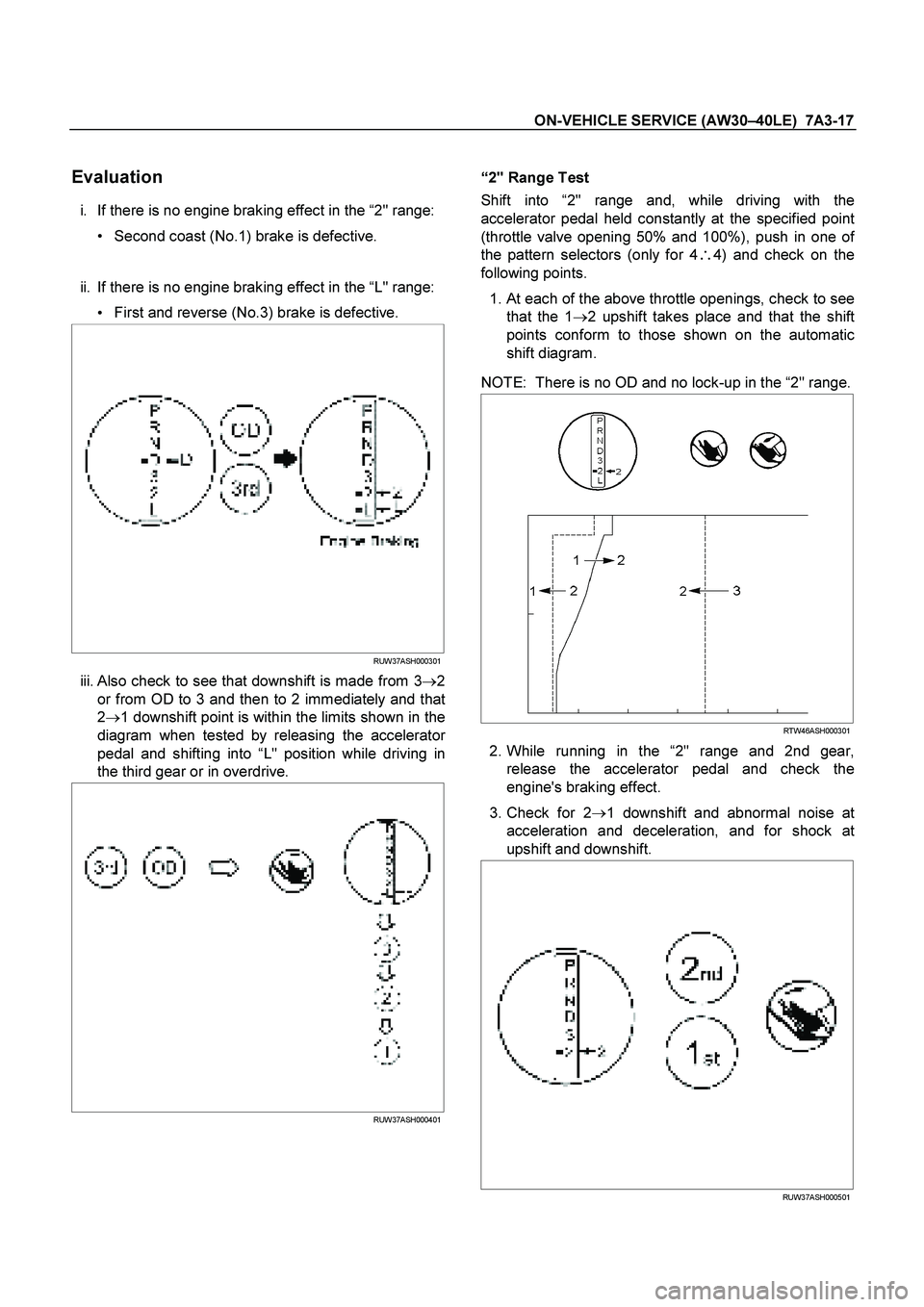
ON-VEHICLE SERVICE (AW30 –40LE) 7A3-17
Evaluation
i. If there is no engine braking effect in the “2" range:
Second coast (No.1) brake is defective.
ii. If there is no engine braking effect in the “L" range:
First and reverse (No.3) brake is defective.
RUW37ASH000301
iii. Also check to see that downshift is made from 3 �2
or from OD to 3 and then to 2 immediately and that
2 �
1 downshift point is within the limits shown in the
diagram when tested by releasing the accelerato
r
pedal and shifting into “L" position while driving in
the third gear or in overdrive.
RUW37ASH000401
“ 2" Range Test
Shift into “2" range and, while driving with the
accelerator pedal held constantly at the specified point
(throttle valve opening 50% and 100%), push in one o
f
the pattern selectors (only for 4
�4) and check on the
following points.
1.
At each of the above throttle openings, check to see
that the 1 �
2 upshift takes place and that the shift
points conform to those shown on the automatic
shift diagram.
NOTE: There is no OD and no lock-up in the “2" range.
RTW46ASH000301
2. While running in the “2" range and 2nd gear,
release the accelerator pedal and check the
engine's braking effect.
3. Check for 2 �
1 downshift and abnormal noise at
acceleration and deceleration, and for shock at
upshift and downshift.
RUW37ASH000501
Page 3774 of 4264
7A3-18 ON-VEHICLE SERVICE (AW30 –40LE)
“ L" Range Test
1. While running above 80 km/h (50 mph) in the “D"
range, release your foot from the accelerator pedal
and shift into the “L" range.
Then check to see that the 2 �
1 downshift occurs at
the specified point shown on the automatic shift
diagram.
RUW37ASH000601
2. While running in the “L" range, check to see that
there is no upshift to 2nd gear.
3. While running in the “L" range, release the
accelerator pedal and check the engine braking
effect.
4. Check for abnormal noise during acceleration and deceleration.
RUW37ASH000701
“ R" Range Test
Shift into the “R" range and, while starting at full throttle,
check for slipping.
RUW37ASH000801
“ P" Range Test
Stop the vehicle on a grade (more than 9%) and afte
r
shifting into the “P" range, release the parking brake.
Then check to see that the parking lock pawl holds the
vehicle in place.